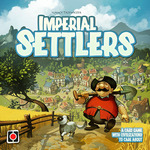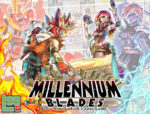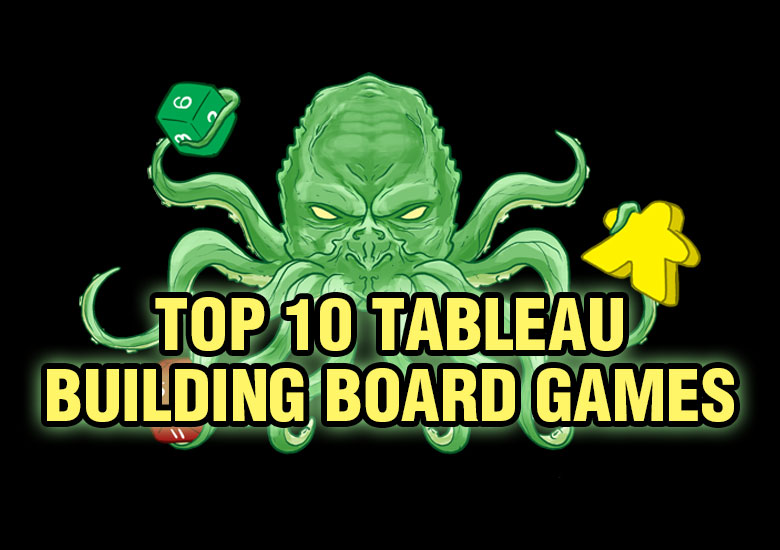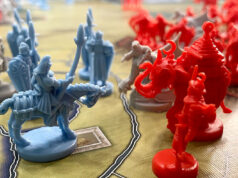Board gaming introduces words and phrases that are not used in everyday vocabulary. Things like worker placement, dexterity, legacy, and bag-building all have different contexts once you start playing more and more games. Today I’m giving a Top 10 based on another one of those phrases: tableau building.
First, I need to establish what tableau building is. I asked around the staff and even some listeners of the podcast Dads on a Map (thanks to Zach and Joe for the help). The big thing to ask when evaluating if a game is a tableau builder (based on my definition of the genre) is the availability or use of actions. In many games that BGG has listed as tableau builders, all actions are available to all players through systems like worker placement or general action selection. Games like Agricola, Castles of Burgundy, or Terra Mystica use player boards that work toward their scoring and economic income, but actions and their availability are rarely impacted. But games like Wingspan or Terraforming Mars (games that are not on my list) would be classified as tableau building because the cards you add to your player area provide new actions and improve others.
In a roundabout way, we came to a bit of a revelation that CCGs like Magic the Gathering could be classified as tableau builders under this definition. Many actions like attacking or tapping are not available from the get-go. The debate is still out on Magic: The Gathering, but I spent the latter half of 2020 playing as many tableau builders as I could get my hands on. Some come in a box that fits in a pocket, others are stored in a Ticket to Ride sized box. No matter the size, they all offer something unique and noteworthy to the genre.
Top 10 Tableau Building Board Games
10. Glory to Rome (review)
 This was just mentioned on the 10 Grail Games List, but Glory to Rome really is worthy of its grail status. Like other games on this list, all the cards can be built for game-breaking abilities and it utilizes the follow mechanic using those same cards. Glory to Rome is one of those games where every action taken by the players is an opportunity to get ahead. It scales well, something many of these games struggle with. It barely makes the list due to the unavailability and mechanics that other games, quite frankly, do better. If you have the opportunity to try it, it’s worth it just to mark it off the bucket list.
This was just mentioned on the 10 Grail Games List, but Glory to Rome really is worthy of its grail status. Like other games on this list, all the cards can be built for game-breaking abilities and it utilizes the follow mechanic using those same cards. Glory to Rome is one of those games where every action taken by the players is an opportunity to get ahead. It scales well, something many of these games struggle with. It barely makes the list due to the unavailability and mechanics that other games, quite frankly, do better. If you have the opportunity to try it, it’s worth it just to mark it off the bucket list.
2-5 Players • Ages 12+ • 60 minutes • Out of Print
9. At the Gates of Loyang (review)
 Is this a tableau builder or a traditional eurogame? Why not both? While this Uwe Rosenburg game has a lot of similarities with his other games, like collecting crops and selling vegetables, the big difference in At the Gates of Loyang is that players draft the ways they acquire and sell those veggies. While everyone begins with similar components, the way one works to make money to pay for points is going to branch out based on the cards added to their tableau. Different types of customers will pay in different ways. There’s trading with the local market stalls to get new veggies, and helpers are there to provide special abilities. It’s not the typical tableau builder you’d think of, but it might be the one to look at for fans of eurogames.
Is this a tableau builder or a traditional eurogame? Why not both? While this Uwe Rosenburg game has a lot of similarities with his other games, like collecting crops and selling vegetables, the big difference in At the Gates of Loyang is that players draft the ways they acquire and sell those veggies. While everyone begins with similar components, the way one works to make money to pay for points is going to branch out based on the cards added to their tableau. Different types of customers will pay in different ways. There’s trading with the local market stalls to get new veggies, and helpers are there to provide special abilities. It’s not the typical tableau builder you’d think of, but it might be the one to look at for fans of eurogames.
1-4 Players • Ages 10+ • 60-120 minutes • $42
8. Villagers (review)
 We move on to one of the most streamlined tableau builders. In Villagers, players repeat two phases until the game ends: drafting and building. The cards added to a tableau can increase the number of cards drafted, increase the number of cards built, or can provide victory points when one of the two market cards are revealed. Many cards have a production order that they must be played in. To play the Cartwright, as an example, that player must have played a Lumberjack first, a Wheeler on top of that Lumberjack, and then can add the Cartwright. Certain cards also have a padlock on them, and whoever has the card listed by the padlock (even if it’s the same player as the one playing the padlock) will get VP that sits on the card and score during the market phase. The rules are super basic, yet each game somehow feels different, and I’m keen on introducing this to non-gamers.
We move on to one of the most streamlined tableau builders. In Villagers, players repeat two phases until the game ends: drafting and building. The cards added to a tableau can increase the number of cards drafted, increase the number of cards built, or can provide victory points when one of the two market cards are revealed. Many cards have a production order that they must be played in. To play the Cartwright, as an example, that player must have played a Lumberjack first, a Wheeler on top of that Lumberjack, and then can add the Cartwright. Certain cards also have a padlock on them, and whoever has the card listed by the padlock (even if it’s the same player as the one playing the padlock) will get VP that sits on the card and score during the market phase. The rules are super basic, yet each game somehow feels different, and I’m keen on introducing this to non-gamers.
1-5 Players • Ages 10+ • 30-60 minutes • $25
7. Pax Renaissance
 At one time, this was in my Top 5 of all time. I still have a vast appreciation for this game, but it’s been three years since my last play of it. Each game isn’t going to have every card in play, so that creates for lots of variance. Cards are going to help work toward the four different victory conditions, manipulate units on the mainboard (which is also made up of cards), add abilities and actions to your tableau, and give historical text about the subject on the card. One of the key factors in Pax Renaissance is that the units shaped like Chess pieces do not belong to any individual player, but in fact are used by the religious factions of the time period: Reformation, Islam, or Catholicism. It’s the heaviest game on my list for certain. The rules are dense and strategy is incredibly cloudy, but if you can overcome those things, there is maybe more to explore than any other game I’ve featured.
At one time, this was in my Top 5 of all time. I still have a vast appreciation for this game, but it’s been three years since my last play of it. Each game isn’t going to have every card in play, so that creates for lots of variance. Cards are going to help work toward the four different victory conditions, manipulate units on the mainboard (which is also made up of cards), add abilities and actions to your tableau, and give historical text about the subject on the card. One of the key factors in Pax Renaissance is that the units shaped like Chess pieces do not belong to any individual player, but in fact are used by the religious factions of the time period: Reformation, Islam, or Catholicism. It’s the heaviest game on my list for certain. The rules are dense and strategy is incredibly cloudy, but if you can overcome those things, there is maybe more to explore than any other game I’ve featured.
2-4 Players • Ages 12+ • 60-120 minutes • $95
6. Imperial Settlers (review)
 Tony is certainly right about this one. I was excited to try 51st State: Master Set due to the shared deck, but the factions and simplified resources elevate Imperial Settlers. The system revolves around cards having three uses: making a deal to get the resource each turn, constructing that building for yourself, or destroying the card to get the resources once. The art isn’t nearly as strong as 51st State, but it’s still inviting to see the happy little people of each nation. I’ve only played the four factions in the base set, so exploring those differences is quite appealing. For me, the factions as well as the speed of turns make this a high-tier tableau builder.
Tony is certainly right about this one. I was excited to try 51st State: Master Set due to the shared deck, but the factions and simplified resources elevate Imperial Settlers. The system revolves around cards having three uses: making a deal to get the resource each turn, constructing that building for yourself, or destroying the card to get the resources once. The art isn’t nearly as strong as 51st State, but it’s still inviting to see the happy little people of each nation. I’ve only played the four factions in the base set, so exploring those differences is quite appealing. For me, the factions as well as the speed of turns make this a high-tier tableau builder.
1-4 Players • Ages 10+ • 45-90 minutes • $37
5. Isle of Trains
 I’m even shocked at how high this game landed. The game seems so unassuming with its wallet-sized box, kids-book art, and total component count being 55 cards. But what Isle of Trains does right is the handling of interaction. See, Isle of Trains is all about delivering goods that are loaded on train cars. Cards can be built, loaded as a good, or spent to pay for things. When loading a good onto your own train car, nothing is triggered. But if you load a good onto an opponent’s car, the ability listed triggers for you. This is such a good twist, because to gain access to more options on your turn, you must award an opponent with the very thing that will score them points. It continues to grow on me because nearly all the interaction isn’t in a take-that manner. Much of the interaction you see in games on this list is to halt their progress. Isle of Trains subverts that.
I’m even shocked at how high this game landed. The game seems so unassuming with its wallet-sized box, kids-book art, and total component count being 55 cards. But what Isle of Trains does right is the handling of interaction. See, Isle of Trains is all about delivering goods that are loaded on train cars. Cards can be built, loaded as a good, or spent to pay for things. When loading a good onto your own train car, nothing is triggered. But if you load a good onto an opponent’s car, the ability listed triggers for you. This is such a good twist, because to gain access to more options on your turn, you must award an opponent with the very thing that will score them points. It continues to grow on me because nearly all the interaction isn’t in a take-that manner. Much of the interaction you see in games on this list is to halt their progress. Isle of Trains subverts that.
2-4 Players • Ages 13+ • 45 minutes • $15
4. Millennium Blades (review)
 Millennium Blades is an interesting pick for this list. To be honest, the tableau building in this one isn’t the best, hence why I have it at No. 4 even though I would rate the game a 10/10. It’s known for being the economic CCG simulator, not for the tournaments where the tableau building happens. Yet, the buying, selling, and trading of cards is all building towards placing a card one at a time to score the most points in various ways. Cards in your deck score a base value and use keywords to trigger more scoring. Deck boxes and accessories can offer abilities or end game scoring. It’s just a thematic take on the genre for those familiar with a CCG and its community.
Millennium Blades is an interesting pick for this list. To be honest, the tableau building in this one isn’t the best, hence why I have it at No. 4 even though I would rate the game a 10/10. It’s known for being the economic CCG simulator, not for the tournaments where the tableau building happens. Yet, the buying, selling, and trading of cards is all building towards placing a card one at a time to score the most points in various ways. Cards in your deck score a base value and use keywords to trigger more scoring. Deck boxes and accessories can offer abilities or end game scoring. It’s just a thematic take on the genre for those familiar with a CCG and its community.
2-5 Players • Ages 12+ • 80-120 minutes • $80
3. Pax Porfiriana
 Welcome to Mexico around 1900, where the dictator Porfirio Diaz reigns supreme. Pax Porfiriana is the economic game in the genre, where cards played to the tableau are not only to score, but to help build your source of wealth. Industries can be improved, protected, or shaken when the regime changes. Opponents can muscle their way onto your land to make a buck. All the while, there’s competition between the players to gain influence among the different ways to topple Diaz. And if Diaz remains in power, it’s the richest player who wins. Pax Porfiriana is another big box in a small game made up of just cards, cubes, and money. It’s a game of opportunities, whether it’s earning from a player or buying the right cards from the market. It’s one of those games where you’ll want to curse everything the other players do, which fits the theme perfectly.
Welcome to Mexico around 1900, where the dictator Porfirio Diaz reigns supreme. Pax Porfiriana is the economic game in the genre, where cards played to the tableau are not only to score, but to help build your source of wealth. Industries can be improved, protected, or shaken when the regime changes. Opponents can muscle their way onto your land to make a buck. All the while, there’s competition between the players to gain influence among the different ways to topple Diaz. And if Diaz remains in power, it’s the richest player who wins. Pax Porfiriana is another big box in a small game made up of just cards, cubes, and money. It’s a game of opportunities, whether it’s earning from a player or buying the right cards from the market. It’s one of those games where you’ll want to curse everything the other players do, which fits the theme perfectly.
1-6 Players • Ages 12+ • 120 minutes • $45
2. Innovation
 Maybe one of the most divisive choices on the list, Innovation is a civilization card game where you’re racing to break it. Players are working to lay cards of the same color on top of each other in five different colors. The cards have symbols, which you are using to activate certain actions if you are the majority compared to your opponent(s). But certain abilities will allow you to splay stack, showing symbols of cards lower in the stack, giving you a majority in a symbol to give you an action. But that isn’t what breaks the game. It’s the action cards in later eras that can break the game. Not every card will be used or seen in every game, giving lots of varieties to the plays. Innovation is the most chaotic of my ten picks, giving it a different feeling from the rest.
Maybe one of the most divisive choices on the list, Innovation is a civilization card game where you’re racing to break it. Players are working to lay cards of the same color on top of each other in five different colors. The cards have symbols, which you are using to activate certain actions if you are the majority compared to your opponent(s). But certain abilities will allow you to splay stack, showing symbols of cards lower in the stack, giving you a majority in a symbol to give you an action. But that isn’t what breaks the game. It’s the action cards in later eras that can break the game. Not every card will be used or seen in every game, giving lots of varieties to the plays. Innovation is the most chaotic of my ten picks, giving it a different feeling from the rest.
2-4 Players • Ages 12+ • 45-60 minutes • $17
1. Race for the Galaxy (review)
 In my estimation, this is the tableau builder all others are working to best. Much of the game is done with simultaneous action selection, but uses the follow system seen in Puerto Rico and Twilight Imperium. Even when one player doesn’t select an action, that phase still happens if another player picks the action. The catch is the person who selects that action gets a bonus. Strategies feel varied, starting with which world a player begins with. Scoring can come from playing cards, trading goods, or from developments that score in the endgame. What gives Race for the Galaxy the nod as the best is when players are picking their action, you can eye which ones your opponent is selecting so that you can get more stuff done on a turn. It really is sublime and does not feel like a 13-year-old game.
In my estimation, this is the tableau builder all others are working to best. Much of the game is done with simultaneous action selection, but uses the follow system seen in Puerto Rico and Twilight Imperium. Even when one player doesn’t select an action, that phase still happens if another player picks the action. The catch is the person who selects that action gets a bonus. Strategies feel varied, starting with which world a player begins with. Scoring can come from playing cards, trading goods, or from developments that score in the endgame. What gives Race for the Galaxy the nod as the best is when players are picking their action, you can eye which ones your opponent is selecting so that you can get more stuff done on a turn. It really is sublime and does not feel like a 13-year-old game.
2-4 Players • Ages 12+ • 30-60 minutes • $30






















Did you try out Saint Petersburg as you were working in this list?
No Everdell??
So to me Everdell if fine. I have some beefs with it. There can be an overload of information to take in with a hand of cards and ones available in the middle. The worker placement is fairly dull. And I feel the game is carried by its production quality and art. The first thing people mention about Everdell is the tree, which while optional, can hinder viability depending on player count and table configuration.
Now I know I’m in the minority in thinking most of these things, but I don’t feel the need to go back to it again when there are others that do tableau building better. But to each their own.
Well said.. it also plays quite long for what it is. Players are building towards a 15 card tableau with an incentive to extend play as much as possible before preparing a season, and it only gets longer with experienced players.
Why is it called tableau building? I’ve heard of these games as engine building games but never heard the term tableau building before.
Thinking about it, you have a situation where all tableau builders are engine builders, but not all engine builders are tableau builders. What makes tableau builders distinct is that you change the configuration of the components in front of you individually (hence the word tableau), which adds to your income and action economy.
Examples of engine builders that aren’t tableau builders? Roads & Boats, Century: Spice Road, Dominion, and the three I mentioned in the article.
It’s another small box game, but I am fond of KEEP https://boardgamegeek.com/boardgame/185276/keep
Thoughts on 51st State?